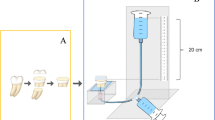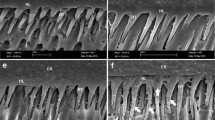Abstract
Objectives
The present study aimed to evaluate the suitability of self-etch adhesives for restoration of deciduous teeth compared with etch and rinse approaches.
Materials and methods
One hundred twenty primary teeth were divided into five groups, each being assigned to an adhesive system. Self-etch adhesives XenoV (XV) and Clearfil S3 Bond (CB), Prime&Bond NT with (PBE)/without preliminary etching (PBN), and Optibond FL (OBFL) as an etch and rinse system were included. Enamel and dentin specimens were prepared (n = 36/group), adhesives applied, and compomer cylinders polymerized. After 24-h storage in 37 °C distilled water and thermo-cycling (1440 cycles, 5/55 °C, 27 s), shear bond tests and fracture mode classification based on SEM investigation were performed. Statistical analysis involved ANOVA and Scheffé procedure with Bonferroni-Holm correction (p ≤ 0.005).
Results
High shear bond strengths to primary enamel were determined for PBE (mean [M] = 22.48 ± 7.7 MPa) > OBFL (M = 19.06 ± 5.62 MPa) > CB (M = 17.6 ± 6.55 MPa), and XV (M = 16.85 ± 5.38 MPa) and PBN (M = 8.26 ± 4.46 MPa) formed significantly less reliable enamel-resin interfaces (p ≤ 0.005). PBE generated the highest bond strength on primary dentin (M = 21.97 ± 8.02 MPa); significantly lower values were measured for XV (M = 13.44 ± 5.43 MPa) and OBFL (M = 12.92 ± 4.31 MPa) (p ≤ 0.005).
Conclusions
Adhesives requiring preliminary etching ensure optimal bond strength to primary enamel. If separate etching is to be avoided, selected self-etch adhesives obtain acceptable shear bond values on primary enamel and dentin.
Clinical relevance
The treatment of pediatric patients presents a great challenge in dental practice, and optimization of treatment processes is important.









Similar content being viewed by others

References
Baelum V, Helderman WV, Hugoson A, Yee R, Fejerskov O (2007) A global perspective on changes in the burden of caries and periodontitis: implications for dentistry. J Oral Rehabil 34(12):872–906
Krämer N, Lohbauer U, Frankenberger R (2007) Restorative materials in the primary dentition of poli-caries patients. Eur Arch Paediatr Dent 8(1):29–35
Marks LA, Faict N, Welbury RR (2010) Literature review: restorations of class II cavities in the primary dentition with compomers. Eur Arch Paediatr Dent 11(3):109–114
el Kalla IH, Garcia-Godoy F (1998) Bond strength and interfacial micromorphology of four adhesive systems in primary and permanent molars. ASDC J Dent Child 65(3):169–176
Turgut MD, Tekcicek M, Olmez S (2004) Clinical evaluation of a polyacid-modified resin composite under different conditioning methods in primary teeth. Oper Dent 29(5):515–523
Krämer N, Tilch D, Lücker S, Frankenberger R (2013) Status of ten self-etch adhesives for bonding to dentin of primary teeth. Int J Paediatr Dent
Krämer N, Frankenberger R (2007) Compomers in restorative therapy of children: a literature review. Int J Paediatr Dent 17(1):2–9
Atash R, Vanden Abbeele A (2005) Sealing ability and bond strength of four contemporary adhesives to enamel and to dentine. Eur J Paediatr Dent 6(4):185–190
Angker L, Swain MV, Kilpatrick N (2003) Micro-mechanical characterisation of the properties of primary tooth dentine. J Dent 31(4):261–267
Borges AFS, Bitar RA, Kantovitzc KR, Correr AB, Martin AA, Puppin-Rontani RM (2007) New perspectives about molecular arrangement of primary and permanent dentin. Appl Surf Sci 254(5):1498–1505
Scheffel DL, Ricci HA, de Souza Costa CA, Pashley DH, Hebling J (2013) Effect of reducing acid etching time on bond strength to noncarious and caries-affected primary and permanent dentin. Pediatr Dent 35(7):199–204
Scheffel DL, Tenuta LM, Cury JA, Hebling J (2012) Effect of acid etching time on demineralization of primary and permanent coronal dentin. Am J Dent 25(4):235–238
Perdigao J, Frankenberger R (2001) Effect of solvent and rewetting time on dentin adhesion. Quintessence Int 32(5):385–390
German Cecilia C, Garcia Ballesta C, Cortes Lillo O, Perez Lajarin L (2005) Shear bond strength of a self-etching adhesive in primary and permanent dentition. Am J Dent 18(5):331–334
Ricci HA, Sanabe ME, Costa CA, Hebling J (2010) Bond strength of two-step etch-and-rinse adhesive systems to the dentin of primary and permanent teeth. J Clin Pediatr Dent 35(2):163–168
Marquezan M, da Silveira BL, Burnett LH, Jr., Rodrigues CR, Kramer PF (2008) Microtensile bond strength of contemporary adhesives to primary enamel and dentin. J Clin Pediatr Dent 32 (2):127–132
Van Meerbeek B, Yoshihara K, Yoshida Y, Mine A, De Munck J, Van Landuyt KL (2011) State of the art of self-etch adhesives. Dent Mater 27(1):17–28
Felizardo KR, Lemos LV, de Carvalho RV, Gonini Junior A, Lopes MB, Moura SK (2011) Bond strength of HEMA-containing versus HEMA-free self-etch adhesive systems to dentin. Braz Dent J 22(6):468–472
Nikhil V, Singh V, Chaudhry S (2011) Comparative evaluation of bond strength of three contemporary self-etch adhesives: an ex vivo study. Contemp Clin Dent 2 (2):94–97
Frankenberger R, Kramer N, Petschelt A (2000) Long-term effect of dentin primers on enamel bond strength and marginal adaptation. Oper Dent 25(1):11–19
Guelmann M, Shapira J, Silva DR, Fuks AB (2011) Esthetic restorative options for pulpotomized primary molars: a review of literature. J Clin Pediatr Dent 36(2):123–126
Braga RR, Meira JB, Boaro LC, Xavier TA (2010) Adhesion to tooth structure: a critical review of “macro” test methods. Dent Mater 26(2):e38–e49
De Munck J, Mine A, Poitevin A, Van Ende A, Cardoso MV, Van Landuyt KL, Peumans M, Van Meerbeek B (2012) Meta-analytical review of parameters involved in dentin bonding. J Dent Res 91(4):351–357
Scherrer SS, Cesar PF, Swain MV (2010) Direct comparison of the bond strength results of the different test methods: a critical literature review. Dent Mater 26(2):e78–e93
Salz U, Bock T (2010) Testing adhesion of direct restoratives to dental hard tissue—a review. J Adhes Dent 12(5):343–371
Lemos LV, Felizardo KR, Myaki SI, Lopes MB, Moura SK (2012) Bond strength and morphology of resin materials applied to the occlusal surface of primary molars. Int J Paediatr Dent 22(6):435–441
Lenzi TL, Guglielmi Cde A, Umakoshi CB, Raggio DP (2013) One-step self-etch adhesive bonding to pre-etched primary and permanent enamel. J Dent Child (Chic) 80(2):57–61
Hegde MN, Bhandary S (2008) An evaluation and comparison of shear bond strength of composite resin to dentin, using newer dentin bonding agents. J Conserv Dent 11(2):71–75
Chandki R, Kala M (2011) Total etch vs self etch: still a controversy in the science of bonding. Archives of Oral Sciences & Research 1 (1):38–42
Cehreli ZC, Akca T, Altay N (2003) Bond strengths of polyacid-modified resin composites and a resin-modified glass-ionomer cement to primary dentin. Am J Dent 16 Spec No:47A-50A
Park JW, Ferracane JL (2014) Water aging reverses residual stresses in hydrophilic dental composites. J Dent Res 93(2):195–200
Gateva N, Kabaktchieva R (2012) Hybrid layer thickness in primary and permanent teeth—a comparison between total-etch adhesives. Journal of IMAB 18(2):191–199
Lenzi TL, Braga MM, Raggio DP (2014) Shortening the etching time for etch-and-rinse adhesives increases the bond stability to simulated caries-affected primary dentin. J Adhes Dent
Hiraishi N, Yiu CK, King NM (2008) Effect of acid etching time on bond strength of an etch-and-rinse adhesive to primary tooth dentine affected by amelogenesis imperfecta. Int J Paediatr Dent 18(3):224–230
Pashley DH, Carvalho RM (1997) Dentine permeability and dentine adhesion. J Dent 25(5):355–372
Gonzalez G, Rich AP, Finkelman MD, Defuria C (2012) Shear bond strength of seventh generation bonding agents on dentin of primary teeth—an in vitro study. Gen Dent 60(1):46–50
Manhart J, Trumm C (2010) Marginal adaptation of an etch-and-rinse adhesive with a new type of solvent in class II cavities after artificial aging. Clin Oral Investig 14(6):699–705
Mahoney P (2013) Testing functional and morphological interpretations of enamel thickness along the deciduous tooth row in human children. Am J Phys Anthropol 151(4):518–525
Acknowledgments
We would like to thank Prof. Dr. Lars Kaderali (Institute for Medical Informatics and Biometry) for his support concerning the statistical evaluation of the measured data.
Conflict of interest
The authors declare that they have no competing interests.
Author information
Authors and Affiliations
Corresponding author
About this article
Cite this article
Kensche, A., Dähne, F., Wagenschwanz, C. et al. Shear bond strength of different types of adhesive systems to dentin and enamel of deciduous teeth in vitro. Clin Oral Invest 20, 831–840 (2016). https://doi.org/10.1007/s00784-015-1560-y
Received:
Accepted:
Published:
Issue Date:
DOI: https://doi.org/10.1007/s00784-015-1560-y



